
Simulation of distortion in an additively manufactured metal manifold, performed with MSC Software Simufact Additive. Image courtesy of MSC Software Simufact.
Latest News
January 3, 2017
Whether emerging from hobbyist-level interest or supported by corporate mandates, AM (additive manufacturing) is becoming more mainstream for prototyping, tooling and production. But a surprisingly large percentage of design engineers (or their management) still don’t make full use of its potential—and here’s why. New users need to understand that just 3D printing the same old part misses out on the potential for lightweighting, simplifying or eliminating assemblies and taking advantage of customized materials. All aspects of the build process are relevant, too. Developing the mindset to create not only one-for-one replacements but optimized versions takes both motivation and the savvy to seek out learning opportunities.
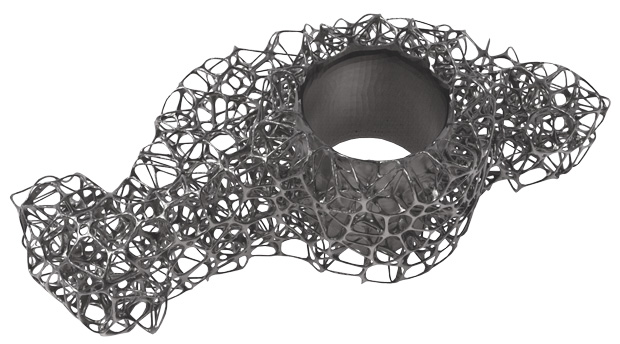 Rendering of internal lattice structure of a metal AM part, stochastically generated with Element software from nTopology. Image courtesy of nTopology.
Rendering of internal lattice structure of a metal AM part, stochastically generated with Element software from nTopology. Image courtesy of nTopology.During this past September’s Additive Manufacturing Industry Summit in Dayton, OH, Stacey DelVecchio, AM product manager for Caterpillar, described the current situation. “Universities are [still] not graduating people that have much knowledge in AM,” states DelVecchio. “Most that do are people who are personally interested in the topic and have explored it themselves.”
She added: “I would like to see mechanical engineers graduated with some basic knowledge of topology optimization. I want them to know these capabilities are here. It gives them a tool to really make something that they’ve never been able to make before.”
“I encourage people to understand more about the ‘physics’ of how the processes work. Each process category, and within each category each type of material, may respond differently when trying to build a specific geometry in a specific orientation. Intuition based upon knowledge of one process or material may or may not be correct when applying it to another process or material.”
—Brent Stucker, CEO, 3DSIM
At the same conference, John Murray, president and CEO at Concept Laser, echoed these thoughts, saying: “The game has changed. These are the tools of tomorrow. For kids who grow up with this, they won’t have the [old] constraints in their minds.”
PTC reinforces this idea on a webpage that simply states: “To incorporate AM, designers must change the way they think and act, and have the right tools to enable success.”
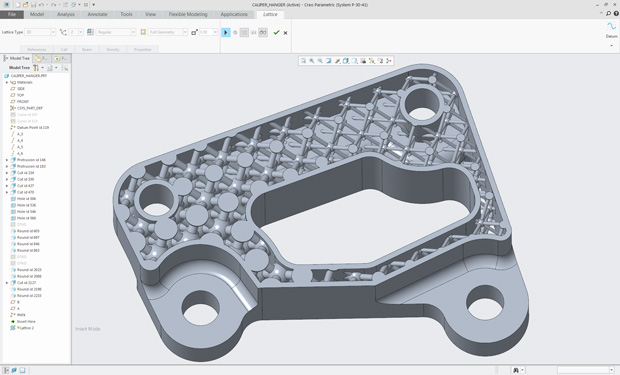 Variable-size internal lattice structure design for an additively manufactured caliper-hanger, created with Creo 4.0 from PTC. Image courtesy of PTC.
Variable-size internal lattice structure design for an additively manufactured caliper-hanger, created with Creo 4.0 from PTC. Image courtesy of PTC.What all that means is AM is not just another approach to part construction; it changes the entire design process.
Fortunately learning to let go of traditional design constraints and think additively is quite do-able, given the increasing variety of resources developed for exactly that purpose. Software companies, design groups, universities and professional organizations all offer practical insight for newbies and experts alike.
Stepping up the Additive Manufacturing Software
Software may be the area of greatest activity this past year, including several exciting, recently announced process simulation products. Look to both big-name companies and much newer entries for highly useful tools and expert insight. 3D CAD programs are a logical place to start, but you’ll find the lines blurring as CAD programs also create lightweight structures, lattice-design companies offer FEA (finite element analysis) simulation, and thermal-process simulation packages drive changes in 3D models.
• ANSYS SpaceClaim is designed to simplify creating, editing and repairing CAD geometry, allow shelling, scaling and splitting models, and, of course, saving models in STL format. Now the ANSYS SpaceClaim STL Prep for 3D Printing module supports doing these tasks directly on STL files or other faceted formats such as OBJ and the new AMF. The latter—Additive Manufacturing File Format—includes some information for color and material.
• Besides its general 3D CAD modeling tools, Autodesk offers solutions for generative design/internal lattice structures (Autodesk Within) and the full AM workflow (Autodesk netfabb: model preparation, support design, custom lattices and design optimization). netfabb also now includes solid-modeling and near-net shape planning based on Autodesk PowerShape technology (formerly Delcam). The latest update incorporates Project Escher’s open-source technology to power AM machines with multiple extrusion-based print heads working together on one part.
• Dassault Systèmes SOLIDWORKS 3D CAD software saves models as STL, AMF and 3MF files. With the 3MF format and Microsoft 8.1 and above, users can also directly preview/manipulate the model on the print bed and set print properties for supported 3D printers.
“AM for prototypes is not the same as AM for production. For prototyping, having multiple geometry translations—like tessellated files, which create data integrity issues—may not be important. But for production, this results in a disconnect between the CAD design and manufactured product.”
—Jose Coronado, product manager, Creo Manufacturing & Creo Simulate products, PTC
• PTC Creo 4.0 includes features that enable designers to design, optimize, validate and run print-checks on AM models in a single environment. It lets users prepare and check STL models before sending them to a printer and create parametrically controlled lattice structures. The software can also send files directly to a Stratasys Connex 3D printer, displaying and calculating support material, setting color and material, and positioning the print in the build volume.
• Siemens PLM Software’s flagship NX CAE product now offers three new technologies relevant to AM. Convergent modeling simplifies the ability to work with geometry consisting of a combination of facets, surfaces and solids, without the need for data conversion; topology optimization includes evaluating a model’s design-for-manufacturability with AM; and the NX Hybrid Additive Manufacturing module simulates the setup of laser metal deposition and NC programming (for metal powders) and multi-axis robotics (for FDM printing and NC post-processing).
• INSPIRE from solidThinking lets designers easily investigate structurally efficient (generative) concepts that can be converted to CAD models suitable for AM. Newer capabilities include polynurbs tools like bridge and wrap, setup tools for enforcing displacements by known amounts (without knowing the force), and analyzing for buckling modes.
“Just because you can make any geometry does not make AM the best process. We all need to evaluate what process can generate the best end product at the most efficient cost. Awareness of more manufacturing processes and capabilities becomes an excellent tool in the hands and mind of a great engineer.”
—Carl Dekker, president and owner, Met-L-Flo
• nTopology is a new entry, with its Element software focused on helping users design, analyze and integrate all manner of 3D-printed internal lattice structures. The basic version is free; the Pro version adds more editing, analysis and data-exchange features, such as Offset Thickening, Stochastic Structures, Conformal Structures and Beam FEA, either a la carte or as a package of add-ons.
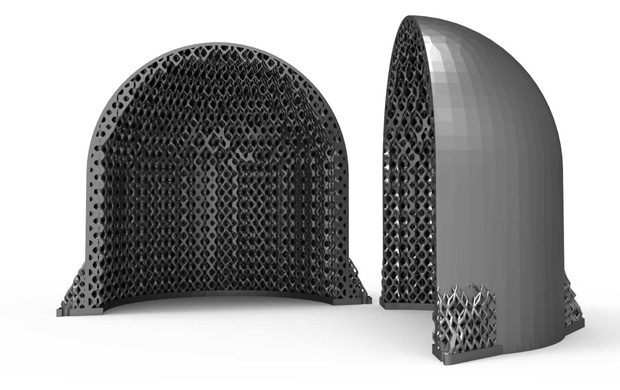 Rendering of internal lattice structure of a metal AM part, stochastically generated with Element software from nTopology. Image courtesy of nTopology.
Rendering of internal lattice structure of a metal AM part, stochastically generated with Element software from nTopology. Image courtesy of nTopology.• 3D Systems has introduced 3DXpert, a software package now available through the company’s acquisition of Cimatron. This all-in-one solution targeted to metal AM helps users import part data, optimize geometry, create lattices, design customized supports, calculate scan-paths, arrange parts on the build platform and set up automated post-processing machining.
• The 10 different products within the Materialise Magics 3D print suite are industrial-grade tools applicable to all sorts of AM systems. Different packages help users optimize and modify (scale, texture, lattices) STL, scanned and CAD data, repair files, automatically create support structures (including for DLP-type bottom-up resin printers), set up the build platform, automate the workflow and more. The company has 25 years of experience providing 3D printing workflow solutions.
• Led by AM expert Phill Dickens, Added Scientific is developing Flatt Pack: the Functional Lattice Package, aimed at providing a simple method to embed triply periodic minimal-surface lattices into common 3D print files, for reduced material consumption and possibly the benefits of thermal management and impact absorption.
Additive Manufacturing Process Simulation/Optimization
Although even the greenest mechanical engineer knows that the actual AM build process is not a push-one-button operation, the entire industry is still at the beginning of working out all the cause-and-effect details. Particularly for metal applications, sufficiently understanding the physics of each process to predict outcomes will drive specific design and/or process steps that can reduce such problems as warpage, uneven layer adhesion and residual stresses.
• 3DSIM’s exaSIM Beta software is a cloud-based AM simulation tool that gives metal-laser-sintering users rapid insight into residual stress and distortion predictions, layer by layer. This information can guide support generation and identify trends; it is based on uniform assumed strain or scan-pattern dependent strain. 3DSIM’s FLEX package, targeted to metal AM researchers, increases understanding of changes in machine, material, geometry and process parameters. Currently, it predicts porosity and melt-pool dimensions; more thermal capabilities are in the works.
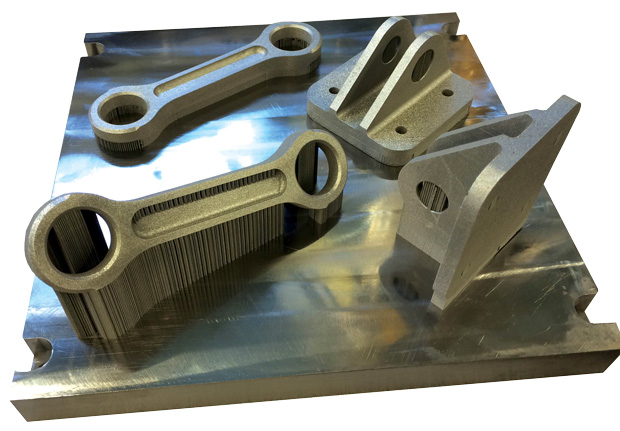 Two additively manufactured Ti64 parts built in two orientations with supports auto-generated by exaSIM simulation software from 3DSIM. Image courtesy of University of Louisville.
Two additively manufactured Ti64 parts built in two orientations with supports auto-generated by exaSIM simulation software from 3DSIM. Image courtesy of University of Louisville.• ANSYS and the University of Pittsburgh Swanson School of Engineering have combined efforts to work on simulation tools that can address melt-pool physics and help designers avoid residual stresses. (See related coverage on page 21.) ANSYS says its next release, v18, will include use of FEA to create microscopic cellular structures within a part to improve its macroscale properties.
• The latest release of Autoesk netfabb helps users test, optimize, prepare and 3D print commercial-quality parts through several new features. Its Simulation for netfabb, built on technology acquired from Pan Computing, predicts part distortion based on process parameters, so designers can allow for them. This option is now available on the cloud.
“Reducing the number of build tests as well as decreasing the build times and optimizing the required support structures (less material) will be a relevant leverage in terms of cost savings, and thus one of the criteria that will bring metal AM to a more mature and economical level.”
—Michael Wohlmuth, CEO of Simufact, MSC Software
• Simufact Engineering, owned by MSC Software since 2015, has added a new offering to its line of manufacturing simulation products, Simufact Additive, for metal laser powder-bed-fusion processes. This software guides users through building calibration parts, correlating measured deformations with predicted values and identifying residual stresses. The influence of different support structures and the varied effects of cutting a part off the base plate can all be evaluated. A thermo-mechanical coupled transient analysis is coming soon.
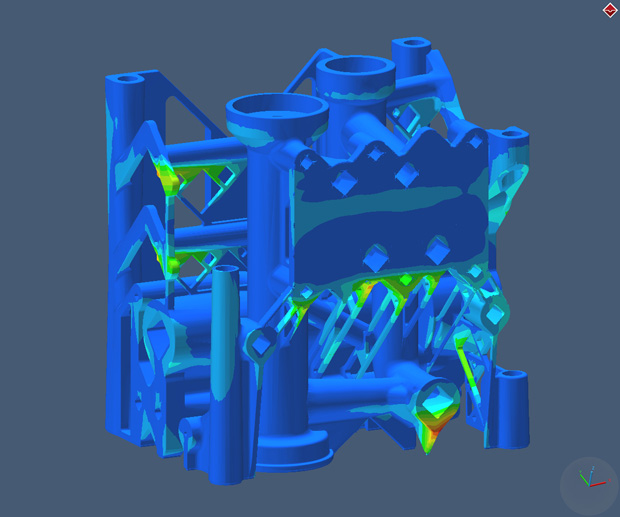 Simulation of distortion in an additively manufactured metal manifold, performed with MSC Software Simufact Additive. Image courtesy of MSC Software Simufact.
Simulation of distortion in an additively manufactured metal manifold, performed with MSC Software Simufact Additive. Image courtesy of MSC Software Simufact.• PrintRite3D, Sigma Lab’s In-Process Quality Assurance (IPQA) software, has been developed to improve repeatability and quality control of many types of manufacturing processes, including AM. The current focus is on direct metal laser sintering (DMLS); the package includes three cloud-based software modules for layer-by-layer temperature monitoring, visual inspection and data analytics. A hardware package integrates various sensors and an interface.
Other Additive Manufacturing Resources
Do not overlook the value of lessons learned dealing with materials themselves and their role in design choices and process definition. The websites of AM equipment manufacturers provide a great starting point.
Additionally, as systems have become more open, third parties that develop, test and supply materials offer another avenue for targeted information. In the latter grouping are Advanced Laser Materials (plastic powders) and DSM (resins and now filaments), and, for metal powders, Advanced Powders & Coatings, Sandvik Osprey, Lucideon and LPW Technology. (Lucideon regularly presents webinars that cover metal-processing challenges.) And coming from yet another angle is Senvol, offering an online, finely searchable information database on AM machines and materials that is both comprehensive and practical.
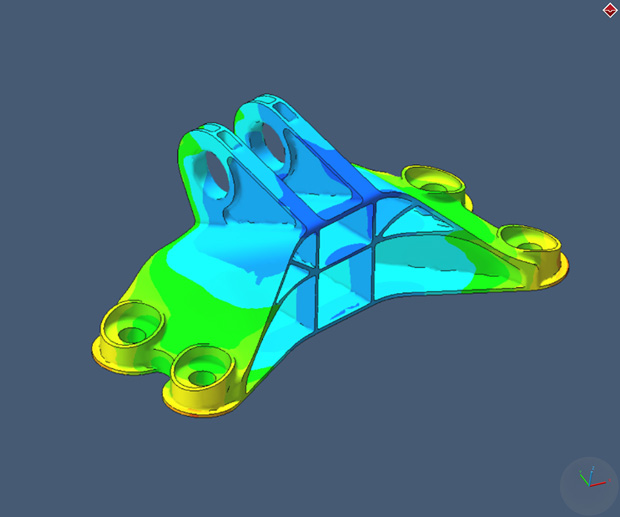 Total distortion in an additively manufactured metal bracket is shown, simulated with MSC Software Simufact Additive. Image courtesy of MSC Software Simufact.
Total distortion in an additively manufactured metal bracket is shown, simulated with MSC Software Simufact Additive. Image courtesy of MSC Software Simufact.Finally, consortiums, training centers and research groups may offer the level of expertise and advice needed for a working partnership; the following is just a sample of the activity.
• Additive Manufacturing Consortium, operated by EWI (Columbus, OH), performs core research in a number of AM-related areas and provides industry support through sponsored projects.
• America Makes, the National Additive Manufacturing Innovation Institute (Youngstown, OH), is a public/private partnership with members from industry, academia, government, non-government agencies and workforce/economic development resources. The goal is to innovate and accelerate AM and 3D printing at a national level.
• Carnegie Mellon University NextManufacturing Center (Pittsburgh) performs research in such areas as AM process modeling and planning, powder spreading and innovative component fabrication by AM; it also offers workforce training and educational outreach.
• SME (Dearborn, MI), in cooperation with the Milwaukee School of Engineering and America Makes, has defined a strategic AM body of knowledge that serves as the basis for its Additive Manufacturing Certificate Program. The certification course provides a solid foundation of AM knowledge.
• University of Louisville AM Competency Center is a joint effort between the university’s long-established additive manufacturing research group and UL, a global safety science organization. The center offers hands-on training in all facets of AM for metals, specialized curriculum addressing AM manufacturing safety, and development of workforce expertise.
More Info
- 3D Systems
- 3DSIM
- Added Scientific
- Advanced Laser Materials
- Advanced Powders & Coatings
- America Makes
- ANSYS
- Autodesk
- Carnegie Mellon NextManufacturing Center
- Caterpillar
- Concept Laser
- Dassault Systèmes SOLIDWORKS
- DSM
- EWI
- LPW Technology
- Lucideon
- Materialise
- Met-L-Flo
- MSC Software Simufact
- nTopology
- PTC
- Sandvik Osprey
- Senvol
- Siemens PLM Software
- Sigma Labs
- SME
- solidThinking
- University of Louisville AM Competency Center
- University of Pittsburgh Additive Manufacturing Research Center
Subscribe to our FREE magazine, FREE email newsletters or both!
Latest News
About the Author
Pamela Waterman worked as Digital Engineering’s contributing editor for two decades. Contact her via .(JavaScript must be enabled to view this email address).
Follow DE





